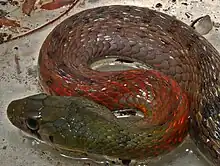Rhabdophis
Rhabdophis is a genus of snakes in the subfamily Natricinae of the family Colubridae. Species in the genus Rhabdophis are generally called keelback snakes, and are found primarily in Southeast Asia.
| Rhabdophis | |
|---|---|
 | |
| Rhabdophis subminiatus | |
| Scientific classification | |
| Domain: | Eukaryota |
| Kingdom: | Animalia |
| Phylum: | Chordata |
| Class: | Reptilia |
| Order: | Squamata |
| Suborder: | Serpentes |
| Family: | Colubridae |
| Subfamily: | Natricinae |
| Genus: | Rhabdophis Fitzinger, 1843 |
| Species | |
|
30, see text. | |
Toxicity
Rhabdophis is often thought of as completely harmless, but there are several cases of severe envenomation and at least one recorded fatality from the Japanese species.[1] The symptoms have been compared to those of highly venomous African colubrids such as the boomslang.[1] Similar reports exist for other species of the genus,[2] which also make reference to the highly hemorrhagic nature of the venom. There is a supposed antivenom in Japan, but not in other countries.[2]
While the term "poisonous snake" is often incorrectly used for a wide variety of venomous snakes, some species of Rhabdophis are in fact poisonous but not venomous. Keelback snakes have salivary glands that secrete poison they ingest from eating poisonous toads. While both venom and poison are toxins, a venom requires direct delivery, for instance subcutaneously through a snake bite, but can be ingested without harm. A poison can also be absorbed indirectly, e.g., by touch or through the digestive system,[3] or delivered by the fang of a poisonous snake.[4][5] Rhabdophis ingest poisonous toads and the poison is absorbed into their blood stream, but the snake is immune to it. The toad poison now accumulates in their salivary glands which is secreted when they bite. Therefore, they use toad poison as their venom. Although this is harmful to small rodents, they cannot harm humans as the concentration of poison secreted is very low.
Species
These species are recognized as being valid:[6]
- Rhabdophis adleri Zhao, 1997
- Rhabdophis akraios Doria, Petri, Bellati, Tiso & Pistarino, 2013 – Singalang keelback
- Rhabdophis angeli (Bourret, 1934) – Angel's keelback
- Rhabdophis auriculatus (Günther, 1858) – white-lined water snake
- Rhabdophis barbouri (Taylor, 1922) – Barbour's water snake[7]
- Rhabdophis bindi Das, E.N. Smith, Sidik, Sarker, Boruah, N.G. Patel, Murthy & Deepak, 2021 – Bindee keelback
- Rhabdophis callichroma (Bourret, 1934) – Bavi keelback
- Rhabdophis callistus (Günther, 1873) – Boettger's keelback
- Rhabdophis ceylonensis (Günther, 1858) – Sri Lanka blossom krait, Sri Lanka keelback
- Rhabdophis chiwen Z. Chen, Ding, Q. Chen & Piao, 2020 – Chiwen keelback
- Rhabdophis chrysargoides (Günther, 1858) – Javanese keelback, Günther's keelback
- Rhabdophis chrysargos (Schlegel, 1837) – specklebelly keelback
- Rhabdophis confusus David & G. Vogel, 2021
- Rhabdophis conspicillatus (Günther, 1872) – red-bellied keelback
- Rhabdophis flaviceps (A.M.C. Duméril, Bibron & A.H.A. Duméril, 1854) – orangeneck keelback, orange-lipped keelback, yellow-headed keelback
- Rhabdophis guangdongensis Zhu, Wang, Takeuchi & Zhao, 2014 – Guangdong keelback
- Rhabdophis helleri (Schmidt, 1925) – Heller’s red-necked keelback
- Rhabdophis himalayanus (Günther, 1864) – orange-collared keelback
- Rhabdophis hmongorum (Kane, Tapley, La & Nguyen, 2023) – H’mong keelback snake
- Rhabdophis leonardi (Wall, 1923) – Burmese keelback
- Rhabdophis lineatus (W. Peters, 1861) – zigzag-lined water snake
- Rhabdophis murudensis (M.A. Smith, 1925) – Muruden keelback, Gunung Murud keelback
- Rhabdophis nigrocinctus (Blyth, 1856) – black-striped keelback
- Rhabdophis nuchalis (Boulenger, 1891) – Hubei keelback
- Rhabdophis pentasupralabialis Jiang & Zhao, 1983
- Rhabdophis plumbicolor (Cantor, 1839) – green keelback, lead keelback
- Rhabdophis rhodomelas (H. Boie, 1827) – blueneck keelback, blue-necked keelback
- Rhabdophis siamensis (Mell, 1931)
- Rhabdophis subminiatus (Schlegel, 1837) – red-necked keelback
- Rhabdophis swinhonis (Günther, 1868) – Swinhoe's grass snake[7]
- Rhabdophis tigrinus (H. Boie, 1826) – tiger grooved-neck keelback, tiger keelback, Japanese grass snake, yamakagashi
Nota bene: A binomial authority in parentheses indicates that the species was originally described in a genus other than Rhabdophis.
References
- Mittleman, M. B.; Goris, R. C. (27 February 1978). "Death Caused by the Bite of the Japanese Colubrid Snake Rhabdophis tigrinus (Boie) (Reptilia, Serpentes, Colubridae)". Journal of Herpetology. JSTOR. 12 (1): 109–111. doi:10.2307/1563518. ISSN 0022-1511. JSTOR 1563518.
- Nelwan, Erni Juwita, et al. (2016)."Severe coagulopathy and transient hypertension following a Rhabdophis subminiatus bite: a case report". Revista da Sociedade Brasileira de Medicina Tropical [online]. 49 (4): 520–522. [Accessed 16 November 2021]. Available from: <https://doi.org/10.1590/0037-8682-0314-2015>. ISSN 1678-9849. https://doi.org/10.1590/0037-8682-0314-2015.
- Oldfield, Molly; Mitchinson, John (10 September 2010). "QI: Quite Interesting facts about deadly poisons". The Telegraph.
- Zotz, R. B.; Mebs, D.; Hirche, H.; Paar, D. (1 January 1991). "Hemostatic changes due to the venom gland extract of the red-necked keelback snake (Rhabdophis subminiatus)". Toxicon. 29 (12): 1501–1508. doi:10.1016/0041-0101(91)90006-D. PMID 1801326.
- Ferlan, I.; Ferlan, A.; King, T.; Russell, F. E. (1 January 1983). "Preliminary studies on the venom of the colubrid snake Rhabdophis subminatus [sic] (red-necked keelback)". Toxicon. 21 (4): 570–574. doi:10.1016/0041-0101(83)90137-X. PMID 6623495.
- Genus Rhabdophis at The Reptile Database. www.reptile-database.org.
- Beolens, Bo; Watkins, Michael; Grayson, Michael (2011). The Eponym Dictionary of Reptiles. Baltimore: Johns Hopkins University Press. xiii + 296 pp. ISBN 978-1-4214-0135-5. (Rhabdophis barbouri, p. 16; R. swinhonis, p. 258).
Further reading
- Fitzinger L (1843). Systema Reptilium, Fasciculus Primus, Amblyglossae. Vienna: Braumüller & Seidel. 106 pp. + indices. (Rhabdophis, new genus, p. 27). (in Latin).